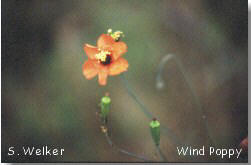![]()
![]()
![]()

More than 300 species of plants have been recorded at the Reserve. Eighteen of the species are on the California Native Plant Society list as sensitive, rare or threatened species. Six plant communities are represented: coastal strand, coastal salt marsh, freshwater marsh, riparian woodland, chaparral and coastal sage scrub.
![]()
Eighty-three species of invertebrates have been recorded, although this is based only on casual observations, due to the lack of focused surveys. The Wandering Skipper, an insect (butterfly) threatened with extinction due to habitat loss, has been observed in the Reserve's salt marshes. Benthic invertebrates are present, but species diversity and richness has been adversely impacted by the fluctuating water quality, particularly the salinity variation.
Diversity and abundance of fish species in
the lagoon depends on water quality
and the condition of the connection to the
sea. When the mouth and channel provide good connection to the ocean, allowing
migration of organisms and good tidal exchange within the lagoon, diversity and
abundance are high. Periodic samplings average 10 - 12 species of fish. During
periods of mouth closure, stress caused by periods of low salinity and oxygen
results in the decline of species numbers and abundance.
Structured sampling of amphibians and
reptiles has not been conducted at the Reserve, but observations indicate that
at least sixteen native and three naturalized reptile or amphibian species are
present. While some are associated with freshwater areas of the Reserve, the
majority are upland species. Sensitive species include the two-striped garter
snake, orange-throated whiptail and San Diego horned lizard.

County staff has documented twenty-six native mammal species and three naturalized species at San Elijo. These include eleven rodents, all three rabbit species occurring in the county, coyote, grey fox, raccoon, bobcat, mountain lion, sea lion and mule deer. Lack of observations of nocturnal mammals, particularly bats, would suggest that it is probable that up to another fifteen species may occur. Some of the mammals observed are permanent residents within the Reserve. Others, particularly mountain lion, mule deer, and sea lion, include the Reserve within their foraging range, but are not entirely dependant on it.
![]()